Design Optimization in the Development of Precision Ovenized Quartz Oscillators
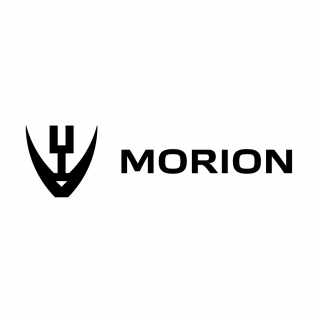
A new precision 10 MHz oven controlled crystal oscillator (OCXO) exhibits low phase noise close to the carrier (-120 dBc/Hz at 1 Hz) and a low noise floor (-160 dBc/Hz at 1 kHz) with very good frequency versus temperature stability.
OCXOs are essential components in modern telecommunication and measurement systems, while requirements for frequency stability versus temperature, thermal hysteresis of frequency, long-term stability, Allan Deviation (ADEV), phase noise and size are becoming more challenging. Meeting these requirements calls for quartz crystal technology improvements and oscillator circuit design optimization.
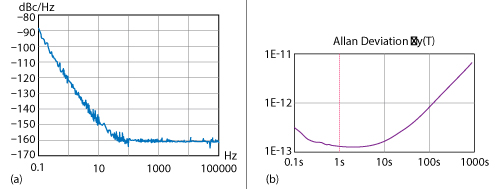
Figure 1 Phase noise (a) and Allan Deviation (b) for a 10 MHz OCXO.
RESONATOR
The evolution of crystal blank processing and the use of cold welding technology for encapsulation have yielded compact quartz resonators of the highest quality while providing the potential for significant size reduction. To achieve the lowest ADEV, special quartz cleaning methods and a number of additional surface finishing processes are used. This along with circuit optimization to reduce intrinsic noise in the electronics results in the phase noise and ADEV performance shown in Figure 1.
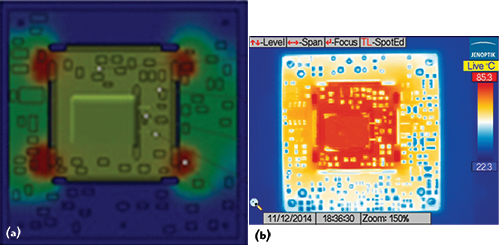
Figure 2 Thermal model (a) and infrared image (b).
THERMAL DESIGN
For reduced size, a single-oven heating system is used. Although difficult to achieve, design experience and the capabilities of modern analysis and optimization software enable the realization of small single-stage oven-controlled oscillators with high frequency stability versus temperature by ensuring low temperature gradients in a zone occupied by the crystal and other thermosensitive parts.1
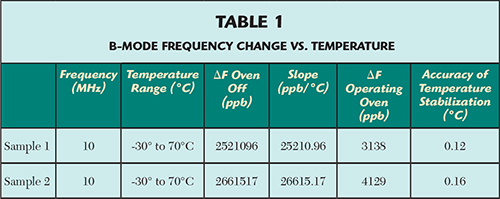
The finite element method is used for thermal modeling. The thermal modeling software takes into account such factors as the individually adjustable thermal conductivity of materials, the area of thermal contact between the material and the heating element, air convection and its influence on the heat transfer, and provides a dynamic thermal map of the design (i.e., during the warming or cooling of the structure). Registration of these factors allows the building of a high fidelity thermal model. Figure 2 illustrates the thermal model of the oscillator and its infrared image. Design optimization achieves such good thermal performance that the influence of temperature on the resonator becomes a negligible contributor to oscillator temperature stability.
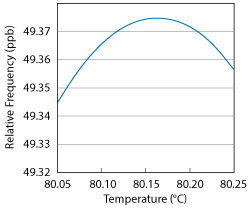
Figure 3 Frequency behavior of SC-cut resonator close to the lower turnover point.
The presence of parasitic (B-mode) oscillation for an SC-cut resonator, located above the main frequency by about 10 percent, provides a means to determine the quality of temperature stabilization while in the oven. The B-mode oscillation has an almost linear frequency versus temperature dependence, so the measurement of B-mode frequency versus temperature enables an estimate of temperature stability. Measurement results are shown in Table 1.
Figure 3 shows the frequency versus temperature characteristic of an SC-cut resonator near the lower turnover point. The data of Table 1 shows that the contribution of the frequency versus temperature dependence of the resonator to the frequency versus temperature dependence of the oscillator is insignificant.
FREQUENCY JUMPS
For some applications, such as timing tasks, the absence of frequency jumps is critical. The nature of this phenomenon is not fully understood; however, on the basis of practical experience we know that two factors are especially important: the cleanliness of the environment in which the resonator is hermetically sealed, and the bonding technology used. Along with additional manufacturing controls, frequency jumps are reduced to a minimum. An example of a continuous frequency measurement during the manufacturing control for frequency jumps is shown in Figure 4.
CONCLUSION
Computer thermal modeling, circuit design optimization and the use of high quality resonators provides a significant improvement in the performance of single-oven oscillators. For a 10 MHz OCXO, frequency stability versus temperature is improved nearly 10 fold (to 4e-10 peak-to-peak from -40° to 85°C), and phase noise close to the carrier is decreased by 10 dB (to -120 dBc/Hz at 1 Hz) along with a low phase noise floor (-160 dBc/Hz at 1 kHz) and a good ADEV (up to 1.5e-13). Final dimensions of the optimized OCXO are 51×51×16 mm.
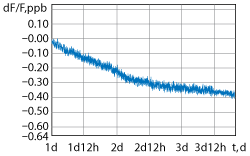
Figure 4 Continuous frequency measurement of a 10 MHz OCXO.
Acknowledgment
The author wishes to acknowledge that this paper was originally presented at the 46thAnnual Precise Time and Time Interval Systems and Applications Meeting in Boston, Mass., December 2014. Y. Vorokhovsky, A. Nikonov, A. Kotyukov and A. Kamochkin, “Efficiency of Circuitry and Design Optimization in Development of Precision Ovenised Quartz Oscillators,” Proceedings of the 46th Annual Precise Time and Time Interval Systems and Applications Meeting (PTTI), Boston, Mass., December 2014.
Reference
1. A.G. Nikonov, A.V. Kotyukov, A.S. Kamochkin and N.I. Dyakonova, “Recent Achievements in Performance of Low Profile Ultra Precision Single Oven Quartz Oscillators,” European Frequency and Time Forum, April 2012, pp. 279–285.




